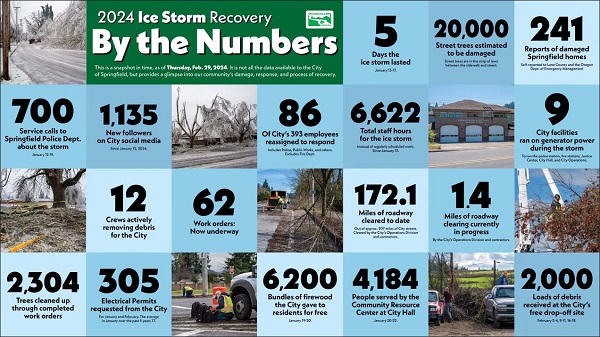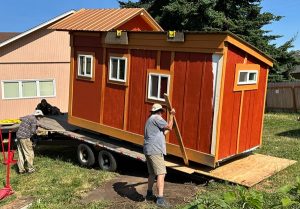Ice storm lessons learned: Springfield
10 min read
Springfield shares lessons learned from the ice storm. At the Lane Preparedness Coalition March 14:
Ken Vogeney (Springfield, emergency manager): I’m Ken Vogeney, the emergency manager for city of Springfield and yes, city of Springfield experienced the ice storm. It was—at least from the collective memory of staff that have been working for the city for over 40 years—this was our worst ice storm experience that we’ve had yet.
There were forecasts from the National Weather Service for a winter storm to be coming in that weekend of the 13th of January. And we were seeing for our area forecasts of about a quarter of an inch of ice accumulation overall.
By the end of the ice storm, five days later, we had areas out in East Springfield/Thurston area with over three inches of accumulation of ice. And most of the rest of the city had on the order of two to two and a half inches. Yes, that’s a lot of ice.
[00:00:58] Our overall estimate for damages and expenses for city of Springfield to respond is sitting at about $5 million. So we’re still working through what all the real costs are going to be. And we won’t know those for quite a while because we still have a lot of stuff that we’re doing.
[00:01:17] We estimated about 20,000 street trees across the city were damaged in some regard. Every block of every city street that has trees on it had tree debris. We had lots of trees damaged.
[00:01:33] The police department reported that during the first five days of the storm, they got over 700 service calls related to the ice storm, just for police.
[00:01:43] I wanted to highlight the 86 out of 393 employees that we reassigned specifically to work on ice storm. That’s across all departments, that’s 22% of the Springfield city workforce—6,622 hours of staff time. In other words, we had the equivalent of 3.2 staff people working full time for a year, in terms of the amount of staff hours dedicated for those first five-six weeks of the storm. A lot of effort.
[00:02:16] Most of the city was without power at some point, including this facility at City Hall and many others. Overall, and I have this in from Springfield Utility Board, over 90% of the community’s power was out at some point; over 23,000 meter services lost power.
[00:02:33] So we don’t know how many individuals or people per se that that represents, but each house has a meter. How many people live at the house? Each business has a meter. Okay, so about 23,000 meters or the equivalent is around 90%.
[00:02:48] The storm duration was five days. It took about 16 days until their system was fully restored. That doesn’t mean all of the people had power back. There’s still some folks out there that haven’t got their electrical systems repaired to their homes or their properties and are continuing without power.
[00:03:08] They (Springfield Utility Board) had a 940% increase in their call volume due to the storm; 80 poles damaged and 157 crossarms, roughly 10.5 miles of wire either had to be repaired or be replaced. And that’s so far, they’re still working. Power’s back, but there’s a lot of temporary stuff that was done to try to get power back. So, there’s ongoing work.
[00:03:33] Four thousand, one hundred and eighty-four people served at the community resource center at City Hall. So during the weekend of the 20th, for three days, Saturday, Sunday, Monday, we opened the lobby of Springfield City Hall as a community resource center. It was being run primarily by county and state staff (with support from city staff) as a place where folks could come in, get warm, recharge and connect with service agencies that they might need.
[00:04:04] They were also distributing food boxes. Over 6,200 bundles of firewood were distributed. People just could come up and get three bundles of firewood in your vehicle and off you go, because we were learning that folks were out of wood to try to stay warm around town.
[00:04:23] But the 4,184 people served, that’s the number of people within households combined that received some kind of service. We’re really happy with that number. And we had that many folks who were able to get service of some kind, either through the city or the other agencies helping provide resources.
[00:04:42] 305 electrical permits were asked for from the city between the start of the storm and Feb. 29. Our average for a January is 77. Why so many electrical permits? You can’t get your power turned back on if your home system is damaged, and you’ve got to get permits and electricians in there to repair it. We have lots of people getting electrical services repaired around town.
[00:05:08] I wanted to highlight 2,000 loads of debris have been received at our debris dropoff site that we opened for the public to bring in debris. We have a six-month lease on a former sawmill site that burned down quite a number of years ago. We have over 30 acres of land there that we can use.
[00:05:32] We allowed the public to come in and just drop their debris. And we were working with Lane Forest Products there to just push all that debris to the site. We have over 2,000 loads that are there, plus loads delivered there by our contractors and city crews, so we don’t know the total number that are on that site yet, but we had that open for three weekends.
[00:05:55] And again, folks were able to drop their debris there at no charge to them. And we’re going to take care of getting all of that chipped and hauled away sometime later.
[00:06:05] We actually had three debris sites functioning—this one that allowed for the public to drop off debris, and then two others that we were using for city crews and the contractor crews.
[00:06:18] We have cleared just over 206 miles of street from tree debris. We had 12 crews, contractor and city; most of the time they were working 12-hour shifts to work on the tree debris.
[00:06:33] So we had crews come in. We did a mutual aid request through the state and Oregon Department of Forestry was able to provide us with, I believe it was four crews. We found a couple of contractors that were able to provide crews. One of those contractors actually brought subcontracted crews out of Northern California. So the ODF crews were here for two weeks. The contractor crews, they were all done by Feb. 29.
[00:07:03] We’re still focusing on getting debris out of the streets. We’re not done with the streets yet. We haven’t entered on to hardly any of our city-owned properties or gone into working on removing debris from things like our drainage canals, stormwater management systems. None of those facilities have been touched yet.
[00:07:23] So we’re going to be working for months as we continue to clean up the debris and continue to find things that have been damaged as we move along.
[00:07:33] We’re also looking at where we are with our repair and restoration of everything. So we’re continuing some damage assessments. One of the areas that we identified early on is actually our streetlight system. About 200 streetlights were damaged through the ice storm. We know we have some damage to some of our buildings, we have damage to some of our vehicles. Still working on getting all those worked out.
[00:08:02] One of the things I wanted to highlight as a lesson learned for Springfield is: We need to be very flexible with our emergency operations center. Through this event, we had five different organizational structures for our EOC. Depending on what the needs were at the time, and the load and pace of activity at the time, we made adjustments.
[00:08:23] My first morning showing up here to open up the EOC, I parked here along the street and realized I didn’t need to worry about turning my wheels to park against the curb. I just needed to get a little bit on that a side slope and just slid right into the curb and just stopped. That was it. Weren’t going any further.
[00:08:42] So when we first opened our EOC on the morning of the 17th, nobody could get here. There was three of us. That was all we could get in the room because others either didn’t get to work if they didn’t have power or phones to report, or they couldn’t physically get here due to the road conditions.
[00:09:03] So I was kind of scrambling. By the end of the day, with some advice from my colleagues over in Eugene and the state, we put in a request to the county to request to the state an incident management team from Oregon Department of Forestry is who actually ultimately came.
[00:09:22] We didn’t ask for a full team. Their full teams are over 50 people. I didn’t need that, but I did need some help. So we asked for eight people to come in and assist us. We also asked by the end of that day to join the county EOC, instead of trying to continue to staff this one, because I came to understand that all of the resources from other agencies that I was going to need to rely on to help Springfield were already in the Lane County EOC.
[00:09:52] So for me to ask for those same things to be duplicated here wasn’t going to be effective or efficient use of the folks that we had available to us, which was very limited because again, people trying to get here, the road conditions were very difficult.
[00:10:11] So we made a request to join the county emergency operations center in what’s called ‘unified command.’ So a county individual and myself were the two commanders for the incident, the county focusing on everybody else in the county and me primarily with the focus on Springfield.
[00:10:33] And then we used that incident management team as our additional staff to help everybody in the county, in addition to Springfield and local, but help everybody with the staffing necessary to be able to accomplish all of the things that we were able to do throughout that ice storm.
[00:10:52] That worked great. We opened the EOC on the 17th. We moved to the county (the) afternoon (of) the 18th, we left the county on the 22nd, and came back here and I brought the incident management team with me, because it was a Thursday and I knew I wasn’t going to be able to get city staff available to cover for the weekend.
[00:11:12] So I had the incident management team here with me in the room for that weekend and then we let them leave on 30th. So they were here with me for five days in here. So worked out great in terms of all that. Then we went to just city staff staffing our emergency operations center until Feb. 11, and then we went to, and in the room, then we went to fully virtual starting the 12th and we’re still in a virtual EOC operation.
[00:11:41] So five different ways of running our emergency operations center. Just by looking at: What’s the pace? What are the needs? Do I really need to have everybody here the whole time, or can we make things work differently? So, very interesting experience. I have lots of thoughts about how to make it better.
[00:12:00] We also learned that different areas of town experienced a different event, based upon how many trees and what variety of trees were in your neighborhood; how much ice there was; how prepared you were, your neighbors were; your ability to communicate or inability to communicate with others; did the cell phone system still work; were you reliant upon the fiber optic communications that were lost for a while? All those things gave people different experiences.
[00:12:31] Even within our City Council, they’ve been talking about, ‘Yeah, this happened to me.’ ‘Well, we didn’t have anything like that. This happened to me.’ Okay. ‘I had a tree fall through my house.’ ‘My house burned down.’ How can we help them, always continuing to try to improve our situational awareness with our other responding entities?
[00:12:49] Other things we learned: We need to expand our ability to communicate with others. We used webpages, social media, news releases, we had some door-to-door activity occurring. We had areas out in the Thurston Hills we could not get vehicles into. Between the ice and the trees, we couldn’t get there. So we had some firefighters, the police chief, a few others trying to walk around and through, while trees and branches are still falling, trying to get through to people’s homes to see if they were okay.
[00:13:27] And they did help get a number of families evacuated for a while and found them places within motels, etc.
[00:13:35] John Q: Springfield sees its worst ice storm in memory, with two to three inches of ice, trees down on every street, and power outages for 90% of the system. Ken Vogeney teams up with the county in a joint emergency operations center, and brings in an state incident management team, to support both jurisdictions. Before the next disaster, Ken hopes to expand Springfield’s ability to communicate when the usual communications systems stop working.
See also: Ice storm lessons learned: Cottage Grove



